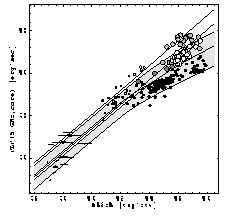
The Silent Majority
Jets and Radio Cores from Weakly Active Black Holes
Heino Falcke
Max-Planck-Institut für Radioastronomie, Auf dem Hügel 69, 53121 Bonn, Germany (hfalcke@mpifr-bonn.mpg.de)Habilitationsschrift, submitted to the University of Bonn
Abstract:
They are weak, they are small, and they are often overlooked, but they are numerous and an ubiquitous sign of accreting black holes: compact radio cores and jets in radio-weak AGN. Here I summarize our work concerning these radio cores and jets in recent years, specifically focusing on the large population of low-luminosity and radio-quiet AGN. Special attention is given to Sgr A*, the supermassive black hole candidate at the Galactic Center, whose radio properties are reviewed in detail. This source exhibits a submm-bump, possibly from an ultra-compact region around the black hole, has unusually high circular but very low linear polarization and is variable at cm-waves where it shows phases of quasi-periodic oscillation. Particularly the compact submm emission is of great interest since it should allow imaging of the event horizon of the black hole in the not too distant future. A jet model is proposed which explains the basic feature of Sgr A*: its slightly inverted radio spectrum, the submm-bump, the lack of extended emission, and the X-ray emission. This model is also applied to famous sources like M81, NGC4258, and GRS1915+105 based on the argument that radio cores are jets whose emission can be scaled with the accretion power over many orders of magnitude. This scaling is corroborated by the detection of many Sgr A*-like radio cores in nearby Low-Luminosity AGN (LLAGN), many of which show jet structures on the VLBI (Very Long Baseline Interferometry) scale. These cores confirm an AGN origin of at least half of the known low-luminosity AGN classified as LINERs and dwarf-Seyferts. It is argued that in fact most of the compact radio emission in LLAGN is produced by a compact radio jet and not an Advection Dominated Accretion Flow (ADAF). Finally, we extend our view to compact radio cores and jets in radio-`quiet' AGN such as Seyferts and radio-quiet quasars. Hubble Space Telescope (HST) and Very Large Array (VLA) images show that jets can have a significant impact on their environment even in these sources. It is also suggested that basically all AGN contain relativistic jets. This idea is strengthened by the first detection of superluminal expansion in a spiral galaxy with a Seyfert nucleus. In general one can say that compact radio cores are a genuine feature of AGN, allowing one to precisely pinpoint black holes in many galaxies.
Paper: Available in full length as PostScript (19Mb), as gzipped PostScript (3.5Mb) and LaTex Format.
Other publications can be found here.
Questions: Heino Falcke, hfalcke@mpifr-bonn.mpg.de